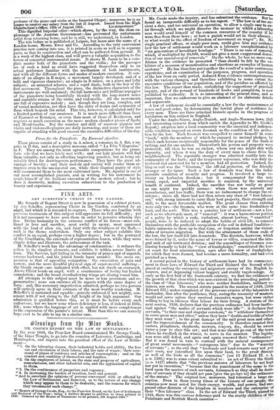Trio for the Pianoforte, Violin, and Violoncello. By _Leopold lama-
There was a concert here in July last, for the benefit of the Hungarian refugees, at which Mademoiselle Anna Zerr' the eminent singer, and M. Jansa, the author of this trio, gave their assistance ; a crime for which Mademoiselle Zerr was deprived of her place of Imperial Chamber singer, and prohibited from reappearing on the stage of the Imperial Theatre at Vienna, and M. Jansa was dismissed from his office in the Emperor's Chapel. The decree cashiering him (which we find in the Vienna in- telligence of a morning paper) is a curious specimen of Austrian petty
tyranny.
"Decree.—Whereas it has been ascertained that Leopold Jansa, violin* at the Imperial Royal Chapel, has not only played in the concert which took place in London on the 12th of fitly for the benefit of the Hungarian refugees, but has likewise composed a duet on Hungarian melodies for that occasion, be is dismissed, by highest command, from his office as violinist and professor of the piano and violin at the-Imperial Chapel; inereovershe-is.no longer to receive any salary from the last of August. Lamed from the High
Gliamberlain's-Office, 12th of August 1861. Irauansseearr."
This dignified Imperial edict--which show; by the way, the close es- pionnage of the Austrian Govermnent--has prevented the unfortunate artist from returning home, and he is still, we understandsin London. The trio before us is published at Leipsie, but bears alatethe-name of a London house, Messrs. Ewer and Ca. According-to the-very convenient practice now coming into use, it is printed in score as well as in separate part; so that ita construction and effect can be gatheredirom perusaL It is a work of the hikhest class, and will: prove a valuable acquisition to the lovers of concerted untrumentar musk. It shows IL RMS.& to be a com- plete master both of the pianoforte and the violin; for the passages are of such a kind as could have suggested themselves only to an actual performer familiar with the mechanism of both instruments, and with all the different forms and modes of modern execution. It con- nate of an allegro insE major, a movement largely developed, and of a boa and vigorous character; an adagio in B minor, on a grave and lofty subject;. an animated scherzo, and a rapid finale, both in the key of the first movement. Throughout the piece, the distinctive characters of the instruments are well sustained; the full harmonies and brilliant arpeggios of the pianoforte being beautifully blended with the long-drawn notes and cantabile strains of the violin and violoncello. All the movements are full of expressive melody ; and, though they are long, complex, and of varied modulation, yet they have the unity of design and symmetry of form which bespeak the artist This trio, however, is calculated only for a- limited portion of our amateurs. It is much more difficult than those of Hummel or Reissiger, or even than most of those of Beethoven, and requires as much execution as the more modern chamber pieces of Spohr and Mendessohn. But the number and skill of amateur pianists and violin and violoncello players are daily increasing, and many of them are capable of attacking with good success the executive difficulties of the day.



























 Previous page
Previous page